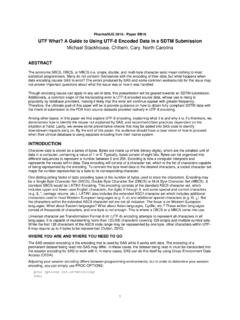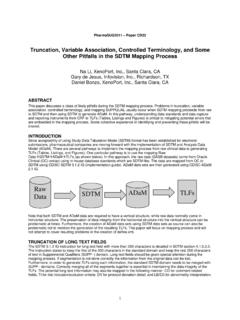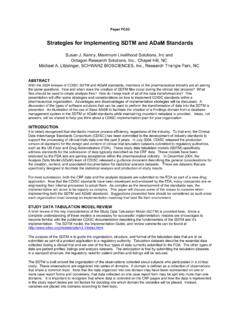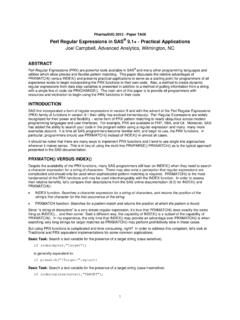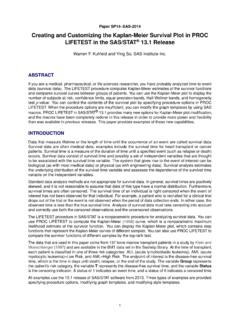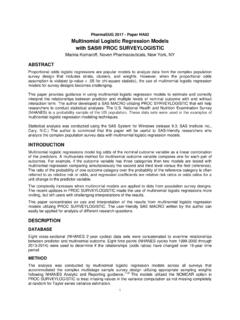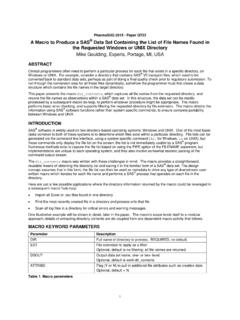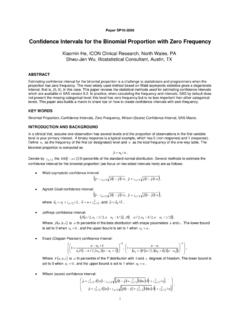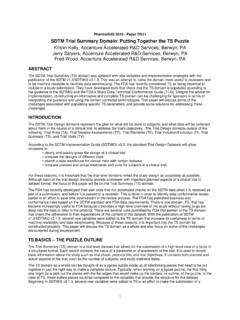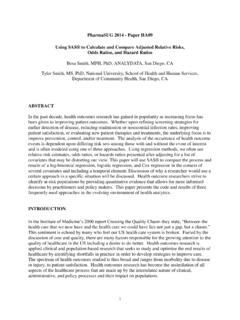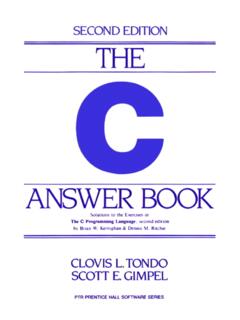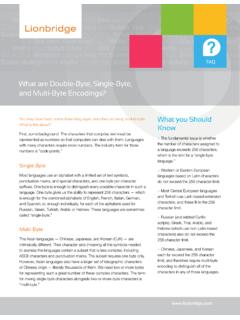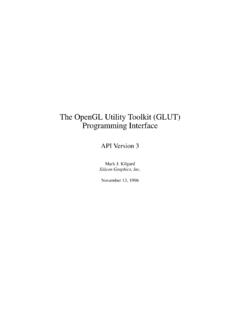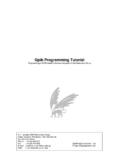Transcription of The Impact of Change from wlatin1 to UTF-8 Encoding in …
1 1 PharmaSUG 2016 - Paper BB15 The Impact of Change from wlatin1 to UTF-8 Encoding in SAS Environment Hui Song, PRA Health Sciences, Blue Bell, PA, USA Anja Koster, PRA Health Sciences, Zuidlaren, The Netherlands ABSTRACT As clinical trials become globalized, there has been a steadily strong growing need to support multiple languages in the collected clinical data. The default Encoding for a dataset in SAS is wlatin1 . wlatin1 is used in the western world and can only handle ascii / ansi characters correctly. UTF-8 Encoding can fulfill such a need. UTF-8 is a universal Encoding that can handle characters from all possible languages, including English.
2 It is backward compatible with ascii characters. However, UTF-8 is a multi-byte character set while wlatin1 is a single-byte character set. This major difference of data representation imposes several challenges for SAS programmers when (1) import and export files to and from wlatin1 Encoding , (2) read in wlatin1 -encoded datasets in UTF-8 SAS environment, and (3) create wlatin1 -encoded datasets to meet clients needs. In this paper, we will present concrete examples to help the readers understand the difference between UTF-8 and wlatin1 Encoding and provide practical solutions to address the challenges above.
3 INTRODUCTION The default Encoding for a dataset in SAS is wlatin1 (or wlatin1 Western (windows) ). wlatin1 is used in the western world and does not suppose Asian characters. With clinical trials become globalized, there has been a steadily strong growing needs to support multiple languages in the collected clinical data. UTF-8 is a universal Encoding that can handle characters from all possible languages. In UTF-8 , ascii was incorporated into the Unicode character set as the first 128 symbols, so the 7-bit ascii characters have the same numeric codes in both Encoding sets ( ascii and UTF-8 ).
4 This allows UTF-8 to be backward compatible with the 7-bit ascii . As such, a UTF-8 file containing only ascii characters is identical to an ascii file containing the same sequence of characters. It is similar for wlatin1 , in which the first 128 symbols have the same numeric codes as in ascii . Thus, as long as you only use the first 128 symbols of ascii (code 000 till 127, your normal keyboard characters like 0, 1, 2, .. 9, a, b, .. z, A, B, .. Z, {, [, }, ] ,|, \, etc.), there will be no problem at all. However, notice that for example, the character is ascii code 129 and is ascii code 230.
5 When transcoding is done from wlatin1 into UTF-8 , then some single byte-characters from wlatin1 (such as and ) might become 2 or 3 byte UTF-8 characters. What happens then? This paper describes the consequences of changing to a new default Encoding in SAS for SAS programmers. WHAT ARE THE DIFFERENCES BETWEEN wlatin1 AND UTF-8 As said, UTF-8 can handle all kinds of characters. It is a multi-byte character set, while wlatin1 is a single-byte character set. It is important to realize the differences of processing data in a single-byte versus a multi-byte environment.
6 One UTF-8 character can be 1 byte, 2 bytes, 3 bytes, or even 4 bytes. To process data in UTF-8 in SAS, you have to use the DBCS string functions (also known as K functions). To use K functions properly, you need to understand the difference between byte-based offset and character -based offset (or length-based). Most of the K functions require character -based offset. In the following, we will use three examples to illustrate the Impact of UTF-8 Encoding . EXAMPLE 1 NOT USE LENGTH STATEMENT To get a better understanding of what this means, see the following simple SAS program: data temp; unit = 'mmol/L'; output; unit = ' mol/L'; output; run; proc print; run; Note that, unless stated otherwise, it is assumed that we are running in a UTF-8 Encoding SAS environment for all the SAS programs.
7 In the example above, the result of the print is probably not what you expect: The Impact of Change from wlatin1 to UTF-8 Encoding in SAS Environment, continued 2 Obs unit 1 mmol/L 2 mol/ Output 1. Output for Example 1 The unit mol/L is not correct. However, the length of unit seems to be 6 for both mmol/L and mol/L. EXAMPLE 2 USE LENGTH STATEMENT Now let us Change the program into: data temp; length unit $ 7; unit = 'mmol/L'; output; unit = ' mol/L'; output; run; proc print; run; Results in the output (which is now as expected): Obs unit 1 mmol/L 2 mol/L Output 2.
8 Output for Example 2 This is what happened. wlatin1 is a single-byte character set, meaning that each character could be stored in one byte. But UTF-8 is a multi-byte character set, meaning that characters need 1, 2, 3 or even 4 bytes to be stored. The special character , needs 2 bytes with UTF-8 Encoding . EXAMPLE 3 LENGTH FUNCTION VS. KLENGTH FUNCTION Let us look at another example: data temp; length unit $ 7; unit = 'mmol/L'; output; unit = ' mol/L'; output; run; data temp; set temp; len = length(unit); klen = klength(unit); run; proc print; run; The output is as follows: Obs unit len klen 1 mmol/L 6 6 2 mol/L 7 6 Output 3.
9 Output for Example 3 Notice that the LENGTH function returns different results: the length of mmol/L is 6 and the length of mol/L is 7. So in other words, the length function returns the number of bytes, not the number of characters in the string. When you use the K-function of function LENGTH, you see that KLENGTH(unit) is the same for mmol/L and mol/L , both return the number of characters, which is 6. It is important to understand that when you process multi-byte data that you should use the DBCS string functions (K functions) instead of our normal functions.
10 The K functions do not make assumptions about the size of characters (number of bytes) in a string; it is a character -based offset function, while the normal functions are byte-based. A byte-based offset assumes that the starting position specified for a character is the byte position of that character in the string. For single-byte data, since one character is always one byte in length, you can assume that the second character in the string begins in byte two of the string. However, if the data in the string is multi-byte, the data in the The Impact of Change from wlatin1 to UTF-8 Encoding in SAS Environment, continued 3 second byte can be one of the following, depending on the data and Encoding of the data: the second character in the string, or the second byte of a 2-byte character , or the first byte of the second multi-byte character in the string.
